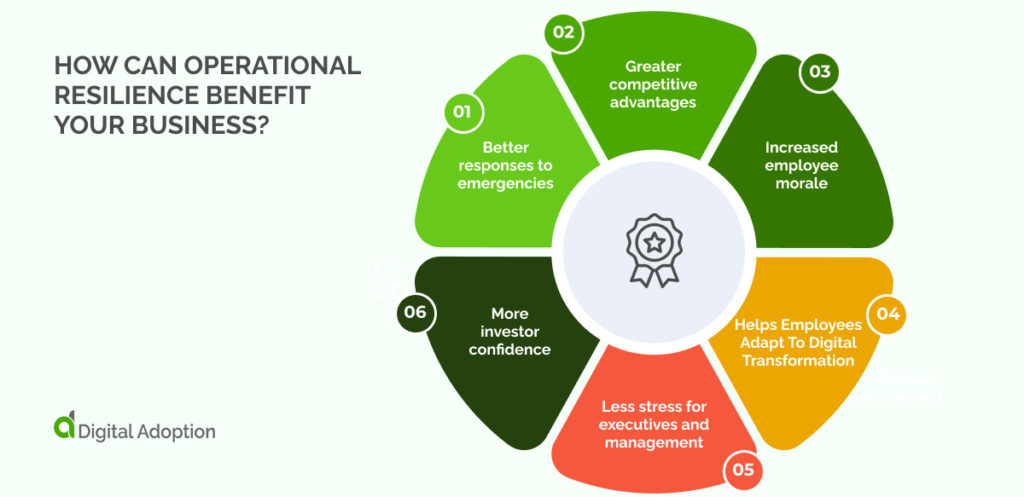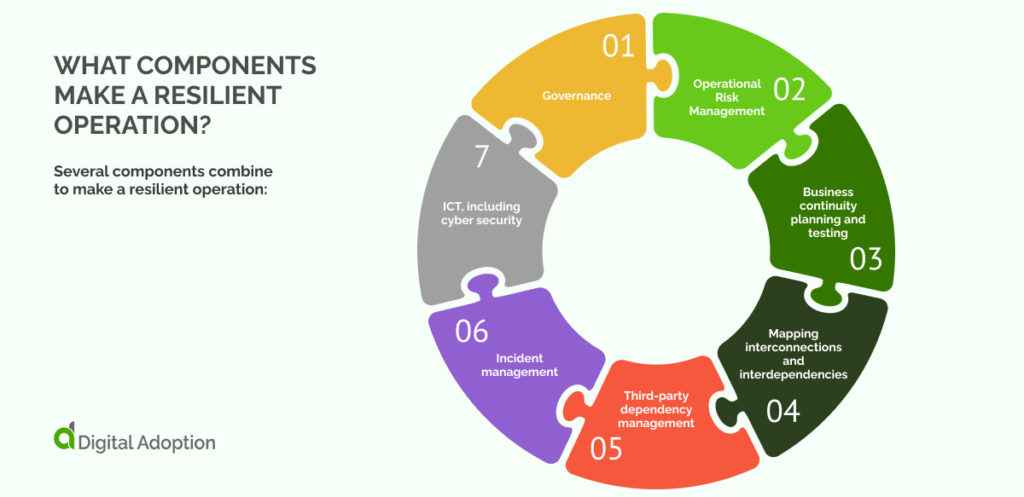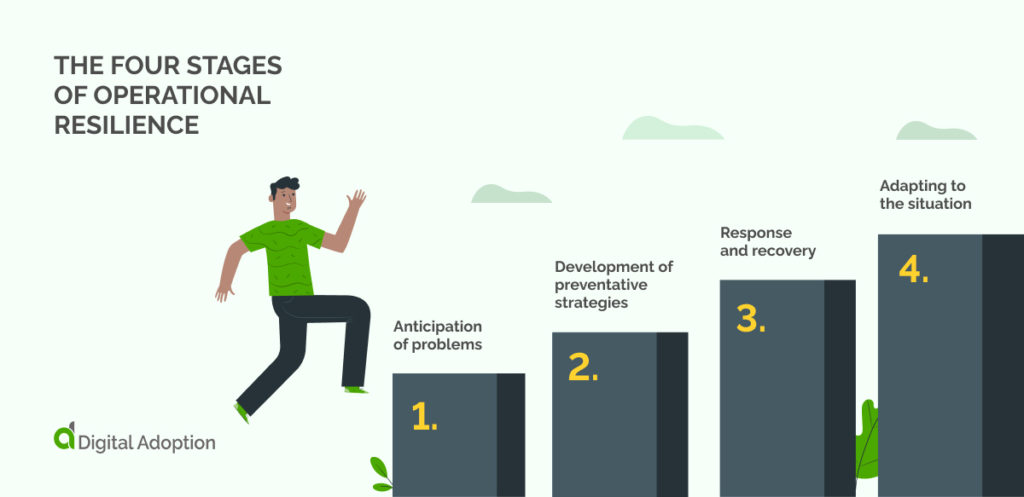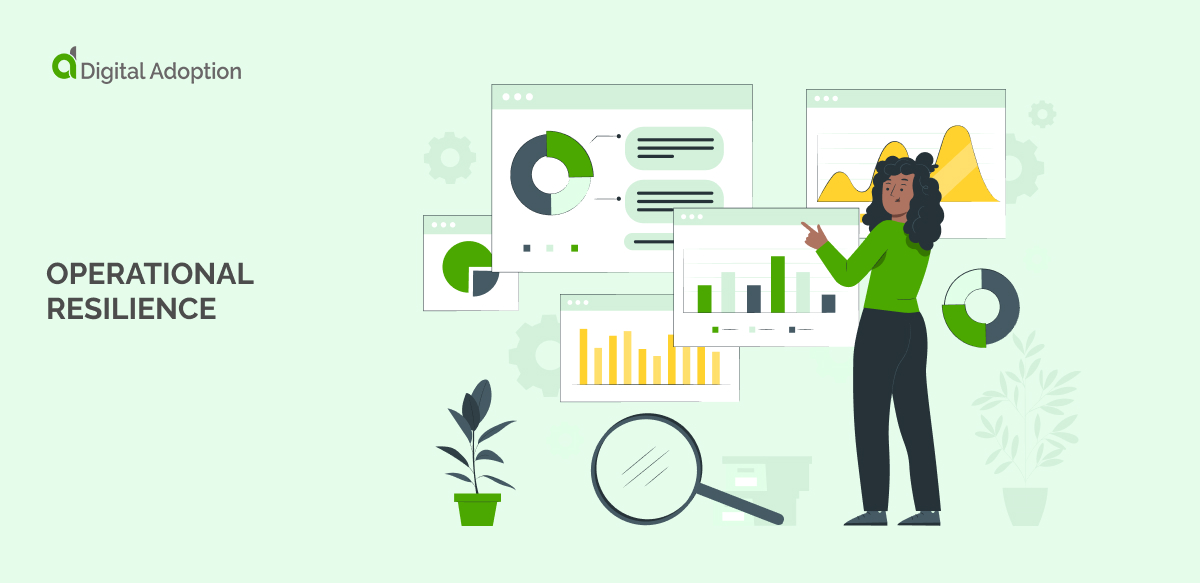Operational resilience refers to an organization’s ability to continue operating and providing services during and after disruptive events such as natural disasters, cyber attacks, or other unexpected circumstances. It involves a set of practices and strategies that help a company quickly adapt to disruptions and minimize the impact on its operations, employees, customers, and reputation.
- What is operational resilience?
- How can operational resilience benefit your business?
- What components make a resilient operation?
- The four stages of operational resilience
- How can you achieve operational resilience in 2023?
- The future of operational resilience
- Invest in a DAP to optimize operational resilience
What is operational resilience?
With successful operational resilience, your business will anticipate and prevent catastrophes, recover from them, and adapt when they occur, allowing you to be constantly flexible in the face of distress, disruption, or uncertainty.
Your future depends on having this ability, so it is vital to invest in operational resilience as a form of insurance for the future: You hope you will never need it, but it must be there just in case.
Now that we have defined operational resilience, let’s look at how it can benefit your business.
How can operational resilience benefit your business?

There are 6 main ways operational resilience can benefit your business as part of your digital business strategy:
- Better responses to emergencies
- Greater competitive advantages
- Increased employee morale
- Helps Employees Adapt To Digital Transformation
- Less stress for executives and management
- More investor confidence
Let’s deep dive into each of them below.
Better responses to emergencies
Constructing resilience allows businesses to bolster their readiness for unforeseen circumstances and potential risks and have contingencies in place if a sudden event disrupts operations. For example, purchasing flood insurance before entering a high-risk area will help prepare for possible natural disasters ahead of time.
Greater competitive advantages
A higher level of resilience gives companies a competitive edge over other organizations. While competitors may be unaware or unprepared for potential risks, your business can identify and prepare in advance for any possible scenarios. In the event of unexpected disruptions, having a plan in place provides firms with greater adaptability that could increase their chances of success.
Increased employee morale
When employees understand the risks their business faces and how their company manages them, it can improve morale within the workplace as it dramatically reduces the fear of the unknown. Doing so has many positive results for organizations: improving employee productivity, decreasing employee churn rates, and improving your bottom line.
Helps Employees Adapt To Digital Transformation
Operational resilience helps employees adapt to digital transformation by providing them with the necessary tools to transition their work. It allows employees to quickly learn new technology, understand how it can help them work more efficiently, and easily carry out tasks independently.
Less stress for executives and management
Business leaders can reduce the stress of unexpected occurrences by fostering a positive environment and having a contingency plan. With their ability to respond rapidly to changing situations, leadership is the core of resilience within an organization.
More investor confidence
When safeguarding your hard-earned money, you need a well-versed enterprise in risk management and resilience. Investors should select a business with a track record of not just avoiding risks but also overcoming turbulent times, so they can have the assurance their investments won’t be compromised even if something unforeseen happens.
Now that we can see the benefits of operational resilience, let’s look at its components.
What components make a resilient operation?

Several components combine to make a resilient operation:
- Governance
To minimize the impact of disruptive events on their critical operations, all companies should take advantage of their existing governance structures to construct and execute a comprehensive operational resilience plan. The plan should enable them to effectively respond, adjust, recover, and learn from potential disruptions.
- Operational Risk Management
Companies should utilize their operational risk management functions to identify internal and external dangers and potential breakdowns in teams, processes, and systems as part of a continuous process.
- Business continuity planning and testing
Companies must develop and carry out business continuity planning in preparation for unexpected yet believable scenarios to test their ability to continue providing essential operations amid disruption.
- Mapping interconnections and interdependencies
To ensure operational efficiency and resilience, companies must determine their critical operations and the web of external connections necessary for these processes.
- Third-party dependency management
Companies must focus on building and maintaining reliable connections with third parties or internal entities to ensure they can achieve their core operations.
- Incident management
Companies should continuously create and execute comprehensive response and recovery plans to handle incidents that may interrupt vital operations in agreement with the company’s risk-tolerance levels. Companies must also improve their incident response and recovery procedures by assimilating information from past experiences.
- ICT, including cyber security
Companies should ensure ICT resilience and cyber security that they monitor securely and regularly test for protection, response, detection, and recovery. Statista research found that highly resilient companies fixed 100% of security breaches in 15 days, while low resilience companies fixed 30% in this time frame, potentially avoiding data loss or damage. Security is imperative to operational resilience to maintain data integrity and prevent damage to the company’s reputation and legal litigation.
Now we have discovered the components of operational resilience, let’s look at its four main stages.
The four stages of operational resilience

Successful businesses striving to avoid challenging and high-risk situations follow a four-stage resilience lifecycle.
1. Anticipation of problems
In the most challenging times, it can be difficult to differentiate which services, employees, and processes are critical for continued progress – whether due to issues such as silos in the organization or inadequate data. To ensure you remain prepared for any potential outcome, execute a what-if scenario analysis and develop plans that cover best-case scenarios, worst-case scenarios, and most likely situations.
2. Development of preventative strategies
Instead of relying on manual processes, automate risk and compliance activities using a single data source across your organization and constantly monitor for events to improve incident response significantly. Doing so allows you to counteract potential incidents before any harm occurs.
3. Response and recovery
It is essential to be proactive about operational continuity rather than waiting until a catastrophe occurs before deciding how to respond. Inadequate dialogue between vendors or suppliers, incorrect or incomplete data, and under-prepared personnel can lead companies into reckless decision-making that could ultimately cause harm.
To ensure your organization’s safety and success, you must create a comprehensive continuity plan that relevant personnel review for approval and effectiveness before implementation.
4. Adapting to the situation
With operational resilience, organizations can bounce back from disasters. However, the focus is often on survival and not taking advantage of the critical insights disruptions provide for learning experiences. Therefore, building programs to adapt quickly and gather valuable information during emergencies is crucial.
Now we have looked at the four stages of operational resilience, let’s examine how to achieve it in 2023.
How can you achieve operational resilience in 2023?
When achieving operational resilience in 2023, you must begin with a resilient culture.
- Nurture a resilient culture
Resilience is more than just a requirement; it should be embraced as an organizational philosophy toward optimized operations. The change leadership must set the tone and ensure that everyone from C-suite executives to IT technicians recognizes its importance — only then will resilience become integral to daily functions.
Within this resilient culture, it is helpful to establish a common language for employees to use when speaking about operational resilience to achieve a more comprehensive analysis and recording of risks.
- Schedule regular operational risk management
You must evaluate risks to determine which targets of resilience measures you should focus on first based on either vulnerabilities or value. During this process, you must also analyze the potential effects of your partnerships’ operational resilience or the lack thereof.
- Define interdependencies
Understand the impact certain events or modifications have on all connected parties, including vendors, partners, customers, workers, departments, and business units. To identify potential chain reactions, take an extensive survey of how external users communicate with your enterprise.
- Engage in resilience testing
To assess readiness, put the team through various challenge scenarios simulations. The tests should include active engagement by all relevant personnel and provide a thorough evaluation of the risk you can use to develop mitigation strategies.
- Reduce risks
Businesses must take prompt action on proposed mitigation measures to ensure successful testing and planning. For example, constructing IT system resilience may necessitate more backup resources or extra network redundancies. When it comes to vendor or partner risk management, you can utilize crisis-readiness contracts to lead responses in the event of a crisis or disruption.
- Use business continuity management (BCP)
Business continuity plans are created within every division of an organization, while operational resilience focuses on ensuring the essential operations and procedures that move through all company sections allowing you to recover them swiftly.
The BCP should begin with a comprehensive Business Impact Analysis (BIA) to precisely determine the coverage area, and companies usually complete these in conjunction with an extensive risk assessment.
- Establish a controlled environment
To drive operational resilience effectively, senior managers must establish a control environment by defining the internal controls that guide operational resilience, such as standards of conduct. Record these standards in a form that is easily accessible to employees.
- Utilize an internal and external communication strategy
Your internal and external communication strategies are how you communicate with your employees, consumers, and clients outside your business. From leveraging social media to talking with shareholders and providing excellent customer service, these tactics allow you to inform all employees and external stakeholders of any changes in service provision to mitigate frustration and damage to your company’s reputation.
Since we now know how to approach an operational resilience strategy in 2023, let’s move on to the future of operational resilience.
The future of operational resilience
It is difficult to predict the future needs of operational resilience technologies as they are built to deal with circumstances yet to occur. However, specific approaches will reduce risk in the coming years.
Follow this list of approaches as guidelines for operational resilience in the future:
- Take a close look at your current approach and use a gap analysis to identify areas for improvement to ensure robust systems of response to risk.
- Examine and assess the possibility of internal and external factors and associated key risks to identify harm caused and the level of response needed.
- Create statements of resilience to demonstrate the effectiveness of your examples and establish where your organization’s vulnerabilities lie.
- Develop flexible processes to incorporate constantly changing conditions within your operational resilience action plans and review them regularly so that action plans can be easily adjusted when disruptions occur.
If you follow these steps, you should be prepared for risk and maintain a high operational resilience level far into the future.
Invest in a DAP to optimize operational resilience
Operational resilience is an organization’s ability to anticipate, prepare for, respond to, and recover from disruptive events, and it is a crucial component of business continuity planning and risk management.
As the world becomes more complex and interconnected, operational resilience will become increasingly crucial for businesses of all sizes. A DAP is an effective way to plan for the future.













